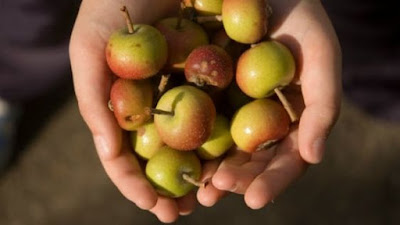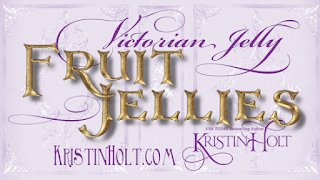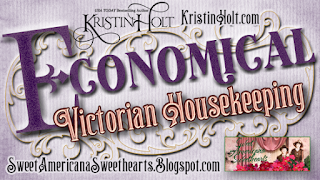by Kristin Holt, USA Today Bestselling Author of
Sweet Romance set in the American Old West
September is Jelly and Preserves Season!
Crabapples
Gorgeous, flowering crabapple trees can be found in temperate climates. Blossom-laden boughs herald the warming days of late spring. The sour fruit is enjoyed in jellies and preserves.
Victorian housekeepers (wives) bottled preserves (whole fruit in syrup) and jellies. Their recipes illustrate 19th century cooking methods differing from the modern.

Flowering crabapple tree, courtesy of Pinterest.
Crabapples are smaller and much more sour than typical apples.

Crabapples, courtesy of Pinterest.
Vintage Crabapple Recipes, 1898
"Making Crabapple Jelly," original to New York Tribune, was reprinted in The Washington Standard of Olympia, Washington on November 11, 1898. This newspaper column provides much more information than appeared in recipe books of the era, thus an ideal example of Victorian-era preserving. I've taken great care to transcribe the article's text precisely, including vintage spelling, odd plurals, and punctuation.
Crabapple Wisdom, 1898
The crabapple is one of the most important fruits that are put up by the house-keeper in the Fall. It makes delicious preserves, and is a most valuable jelly. The tartness and fine, rich flavor of crabapple jelly render it second only to currant. For preserving the fruit the large, red-checked Siberian crabapple should be used, and may be obtained in market at about 40 cents a peck. For jelly, a cheap variety, the little wild crabapple, may be used with the best results and may often be purchased at 20 cents a peck, thus making it one of the cheapest of jellies.
~ The Washington Standard of Olympia, Washington, November 11, 1898
Crabapple Jelly Instructions, 1898
To make crabapple jelly look the fruit over carefully, cut out the stems and the blossom ends, and cut every apples [sic] in halves. Put the fruit in a large double boiler or in a stone jar sit [sic] in a large pot of water, and let the water come gradually to the boiling point around the jar. Be sure that the water reaches up to the fruit. The water must boil around the jar for eight or nine hours, and must be replenished as it boils away. At the end of this time the juice will be drawn out of the fruit and the jar may be removed from the water and left to cool over night. (emphasis added)
~ The Washington Standard of Olympia, Washington, November 11, 1898
Compared to modern crabapple jelly recipes, this Victorian method takes forever.
Read on!
Then strain them through a strong muslin cloth, squeezing out all the juice possible. Measure the juice and allow a pound of sugar to every pint. Boil the juice for 20 minutes before adding the sugar. Then put in the sugar and let it come to a boil for a few minutes longer, until it is firm jelly. Then strain it into jelly-bowls, and when cold cover it with papers and seal it up. Many delicious desserts are made with crabapple jelly, and it is excellent to use for cake.
~ The Washington Standard of Olympia, Washington, November 11, 1898
Note the reference to papers, which were brandy-soaked (or not), cut to the proper size to fully cover the jelly surface, and set directly upon the contents. "Seal it up," in reference to jelly, meant either papers pasted over the top of open jars, glass caps (screw on or clamp), or tin lids which had no threads. Note that none of these methods hamper spoilage (by sterilization and vacuum) the way today's jelly- and jam-bottling methods do.
Crabapple Preserves Instructions, 1898
To make a crabapple preserve, use the whole fruit: after carefully looking it over, put into a preserving kettle with enough water to prevent burning. Let the water come gradually to the boiling point, and simmer until the skins crack. Remove the apples, skin them, and with a thin-bladed French knife take out the cores from the blossom ends, leaving the stems on. Weigh the fruit and allow a pound and a quarter of sugar and a scant cup of water to every pound. Let the water and sugar first boil together until clear, then add the fruit and let it simmer until the crabapples are transparent and tender. Remove the apples with a skimmer and spread them out on platters in the sun to cool and harden. Add a syrup of lemon juice in the proportion of the juice of one lemon to three pounds of the fruit, and let it boil until it is clear. When the fruit is cold and hardened, fill quart jars about three-quarters full and strain the syrup over them, filling the jars on the top. Screw on the covers and when cold tighten down.
~ The Washington Standard of Olympia, Washington, November 11, 1898
Did you notice this vintage crabapple preserve is not processed in a water bath? Even after the fruit sat out in the sun?
How did these preserves keep? Our Victorian ancestors understood that adequate sugar in jams, jellies, and preserves acted as a preservative by inhibiting microbial activity.

Crabapple bough, laden with fruit. Image: Pinterest.
Invitation
Do you make jam and jellies or bottle preserves? What insights can you share about the differences between Victorian jellies (or preserves) and today's?
Have you other thoughts to share? Please scroll down and comment.
Related Articles
Copyright Ⓒ 2021 Kristin Holt LC












No comments:
Post a Comment